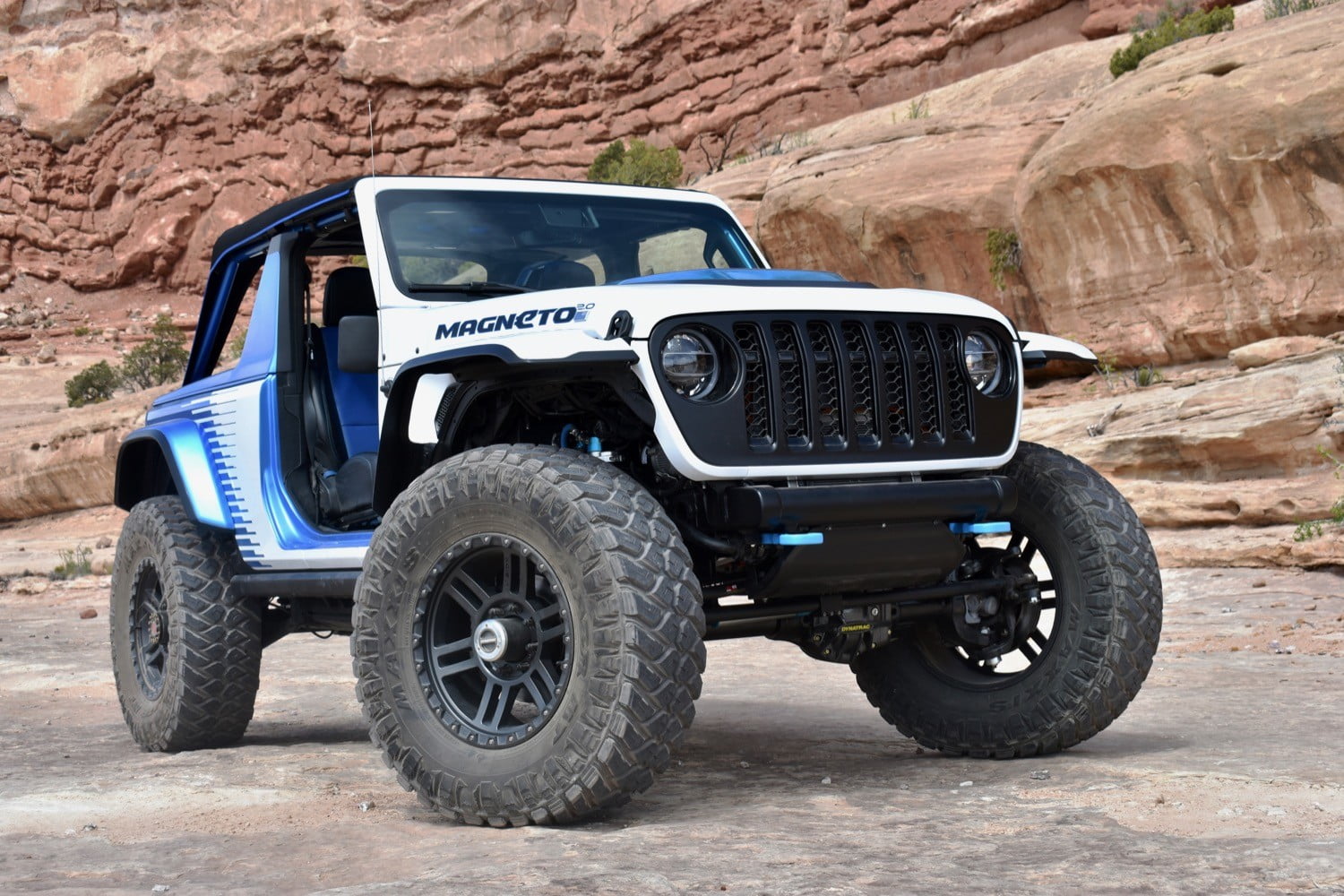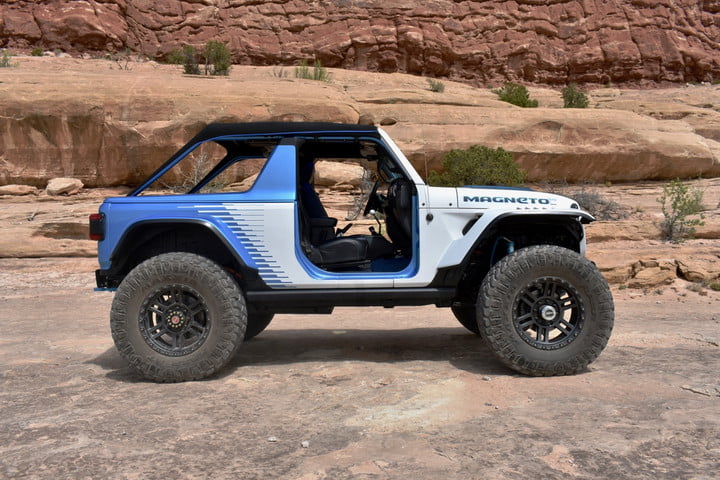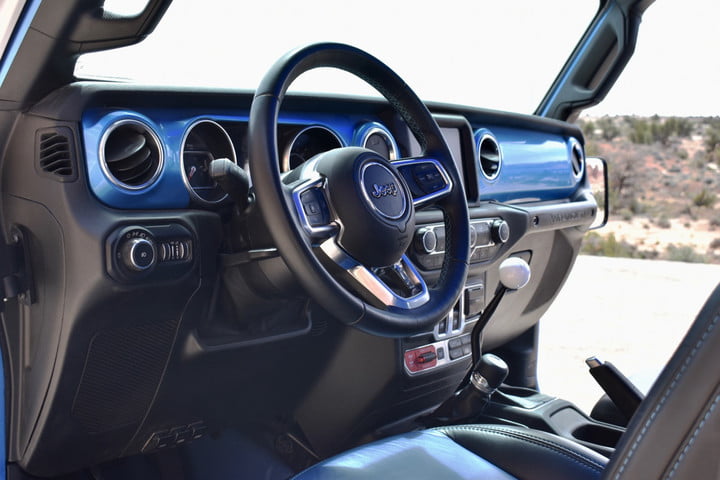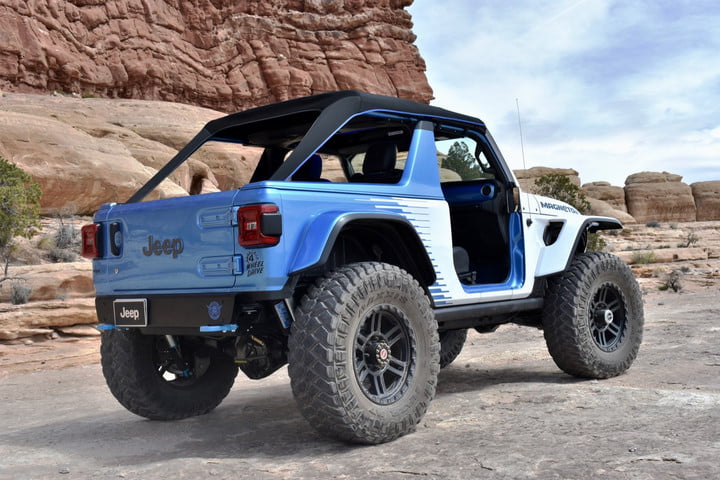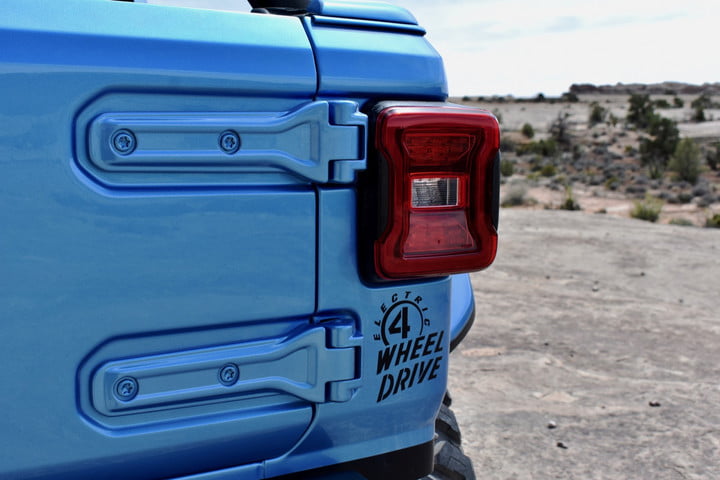Few cars live in the past like the Jeep Wrangler, which exists to carry on the spirit of the original military Jeep that debuted 81 years ago. So you know Jeep is serious about electrification when it rolls out a Wrangler EV concept.
Unveiled at the 2022 Easter Jeep Safari, a massive annual gathering of off-road enthusiasts held in Moab, Utah, the blue and white Magneto 2.0 concept is, as the name suggests, Jeep’s second attempt at an electric Wrangler. The original Magneto concept was just a way to test the waters — now Jeep is diving in.
The Magneto 2.0 concept has power worthy of its supervillain namesake, and the ability to crawl over just about any obstacle. But after hearing the details and taking the wheel for a brief test drive, we found it’s no harbinger of future electric Jeeps.
Design
If Jeep decides to sell an electric Wrangler to customers, it won’t look like this. The Magneto 2.0 is a Frankenstein’s monster on four wheels, with parts that were never made to fit together somehow working in unison.
Jeep did start with a stock Wrangler chassis, but it had to be extensively modified to fit the electric powertrain components. The wheelbase was stretched by 12 inches to make room for them, and power electronics components peek out through a plastic dome in the hood.
Other changes were made to improve the Wrangler’s off-road capability. The concept vehicle rides on enormous 40-inch tires mounted to 20-inch rims. Carbon fiber fender flares covered the enlarged wheels and tires and, along with minimalist bumpers, help reduce weight and improve clearances.
The hood is carbon fiber as well, and Jeep gave the Magneto 2.0 a simple bikini top instead of the typical folding roof. The result looks positively cartoonish, but that was probably the idea.
Specifications
The Magneto 2.0 uses the same electric motor as the original Magneto concept, but instead of the previous 285 horsepower and 273 pound-feet of torque, it now makes 625 hp and 850 lb-ft of torque. That’s way more than any gasoline Wrangler, as well as several sports cars we could name.
That power is harnessed by what seems like an anachronism in an EV: A six-speed manual transmission. Electric cars generally don’t have multi-speed transmissions because their copious torque makes shifting gears unnecessary. However, a manual made sense for a prototype vehicle like the Magneto 2.0 because it allows engineers to try out different gear ratios, Jeep exterior design head Mark Allen said at a media preview of the concept. It also makes off-road driving better.
“This thing crawls amazingly slow, but with full torque,” Allen said, referring to an important characteristic of any off-road vehicle. “I’m always after finesse when we’re off-roading, not just throwing more throttle at it.”
The transmission was sourced from Jeep sibling brand Dodge’s Hellcat V8 muscle cars but still had to be beefed up to handle the electric motor’s power. Robust axles are part of the package as well and, unlike its predecessor, the new and improved Magneto has enough regenerative braking to enable one-pedal driving, Allen claims.
What’s missing from the spec sheet is any mention of range. The massive tires probably don’t help in that area, though, as they increase rolling resistance.
Driving impressions
We took the Magneto 2.0 for a short drive up and down some rock shelves in the desert just outside Moab. We were amazed by the Jeep’s ability to handle these obstacles without breaking a sweat, the smoothness of its power delivery, and the novelty of a manual transmission in an EV.
The electric powertrain solves most of the manual transmission’s problems. The Magneto 2.0 can’t stall, and you can drive off in pretty much any gear and stick with it. The clutch is only needed for shifting gears and, even then, you simply depress it, select the gear, and release. If this catches on, no one will ever be able to brag about learning to drive stick again.
Our low-speed off-road drive didn’t make full use of the Magneto’s 625 hp, but what we did use was meted out with only the slightest prod of the right pedal. The electric motor’s smooth power delivery was an asset off-road, where jerky throttle applications can cause the wheels to break traction. Similarly, the enhanced regenerative braking got used down rock shelves with more consistent braking force than the average human foot can achieve.
What it means for Jeep’s electric future
While Jeep was eager to show off the Magneto 2.0 concept and does have production EVs in development, that doesn’t mean you’ll see an all-electric Wrangler in production anytime soon. If you do, it won’t look like the concept.
“We’re not going to do that in production,” Allen said. “This is a weird test vehicle.” But it does show the potential of electric powertrains for off-roading, and the flexibility they afford engineers and designers. Jeep increased the Magneto’s power output and regenerative braking relatively easily, Allen noted.
“That’s the kind of stuff that I think is super cool about electric powertrains,” he said “It’s the parameters; we can switch those around. We have the ability to do that, and we don’t with gasoline.”
Jeep plans to unveil its first production EV in 2023. The unnamed model will be a crossover SUV more like the current Jeep Compass than the Wrangler. Other electric models will follow, and while the Magneto 2.0 wasn’t intended as a production vehicle, we wouldn’t mind if they shared a bit of its DNA.
